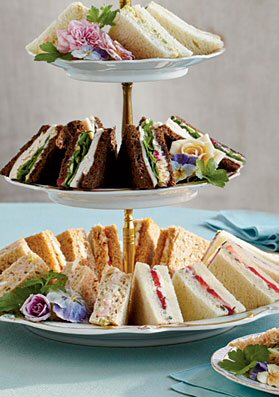☕ Honoring Tradition
Tradition is more than doing what your Mom or Grand Mother has taught you. What your family has done for years and generations are a great way to feel connected to ancestors. But without the stories and the history behind the traditions, those special events or recipes lose some of their esteem and magik.
Today you can find “finger” sandwiches at nearly every party whither or not it’s formal or social. The Tea Sandwich has definitely evolved into something bigger. But not always better.
Evolution is part of life and all things, even family traditions change slightly from time to time. Each generation or person adding their favorite twist on the happening, be it an event or a recipe.
It’s nice to be able to tell the original tale and history of those traditions we hold dear. Where did they come from, how did they start and what was the original intent? All good questions that give importance and imagination to your family traditions.
When I was old enough, my Mom put me to work in helping to get things ready for a party. She would sit me at the dining table, give me ingredients and instructions then let me lose. Of course it wasn’t ever that difficult a task, but it was often fun for a 9 year old girl. I’d roll up cheese balls and coat them in nuts. Or roll up peanut-sweet balls and coat them in sugar. Or, make the finger sandwiches.
The Tea Sandwich Gets Its Start
You don’t have to go back as far as you might think. Only to 1840 with the originator of afternoon tea, Anna Maria Stanhope, the 7th Duchess of Bedford, who was a lady-in-waiting to Queen Victoria.
Afternoon tea was designed to ease the grumbling tummies of polite society in the mid-afternoon. With lunch at noon and dinner at 8pm, mid-afternoon was a perfect time for a mid-day tea with light sandwiches. The sandwiches served at tea time are just filling enough to avoid overindulgence in the scones, cream and jam, yet leave enough room for the scrumptious iced cakes served at the end of the tea.
There are many stories about how the Duchess Stanhope decided upon the size and preparation of the sandwiches. Some say she made the suggestion and the royal chef is really the one who came up with preparation and form.
One of the stories I’ve read relate specifically to the Duchess. She wanted a sandwich that was easy to handle in one hand. Making it easier for the Queen to as she engaged in conversation. The sandwich must be consumed in two bites. Again making sure it was filling, but wouldn’t be over indulgent. And it should not have a crust, because the Queen was not fond of the crust. Another story says no crusts because they add an unnecessary filling to the sandwich.
The sandwich could be long and narrow, a triangular half-sandwich, a quarter square or a small biscuit. Today innovative designs can be cut into decorative shapes with a cookie cutter or with a skillful hand and innovative idea.
Traditionally the bread was always white, thinly sliced, and lightly buttered before the filling was placed inside. The bread crust is cut away cleanly from the sandwich after the sandwich has been prepared and before they are laid out for serving. The evolution of the tea sandwich today allows for variations of bread to include pumpernickel, rye, sour dough or wheat. Other light breads might also be used, including tortillas to fashion small finger size wraps.
The original fillings were “dainty”, light and creamy. They were made with cream cheese or mayonnaise, mixed with a fresh vegetable such as asparagus, cucumber, radish, tomato or watercress. The tea sandwich has grown considerably since the mid-1800s. Today’s fillings include curried chicken, fruit jam, ham with mustard, pimento cheese, smoked salmon and a variety of salads such as chicken, egg, ham, tuna or turkey salad.
Americans have put their twist on the tea sandwich as well, providing light meat and cheese variations. Thinly sliced ham and cheese with light mayonnaise and mustard as an example. As long as the meat is light or less filling, and very thinly sliced it is generally acceptable. Heavy meat such as roast beef is often shunned as a tea time sandwich.
Another modern variation are filings and sandwiches made with or from fruit. Especially something like cantaloupe or honeydew. Wikipedia has a very interesting list of Sandwiches and their origins if you’d like some inspiration.
Whither you’re interested in sticking to tradition and keeping it simple, or you want to update your table with modern variations, the tea sandwich is an integral part of afternoon tea. Make it something you like, but don’t be afraid to try new things or even old favorites.
